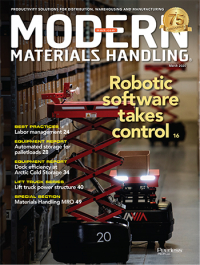Lift Truck Tips: Attachments get a grip on digital transformation
The design, usage and life cycle of attachments should reflect the application and the labor market.
The shortage of lift truck technicians and operators is not just a challenge for operations managers. In an effort to help customers meet these needs, equipment suppliers have been compelled to refine their offerings and introduce new ones. For attachment makers, this translates to a renewed focus on ease of use, efficiency and durability, with the goals of increased productivity, reduced operating costs and minimal burden on maintenance personnel.
“A number of new features and developments address these issues, and digital technology is moving at a pretty fast pace,” says Clark Jordan, vice president of engineering for Cascade Corp. “There’s obviously a lot of turnover at lift truck dealers and in the materials handling technician market, so it’s important for us to be out there to maintain uniform education.”
Even seemingly small improvements can provide substantial relief for technicians, operators and managers. The latest seals and cylinders, which are a hassle to disassemble and repack, are designed to last much longer than their predecessors. New UHMW (ultra-high-molecular-weight polyethylene) load handling bearings are guaranteed for 36 months, nearly double the life of older nylon versions.
“The industry is working hard to design products with much longer maintenance intervals,” Jordan says. “It’s more and more difficult to get qualified technicians and the likelihood of performing service on a predictable and frequent basis gets harder as a result.”
The drive to reduce maintenance cycles leads directly into more energy-efficient products, Jordan adds. “Bearing on bearing” technology for side-shifters use less energy, clamps have lower pressure drops, and both can increase a lift truck battery’s charge duration. Less demand on the truck’s hydraulics can also reduce wear and tear.
“There are lift trucks with much longer maintenance intervals, so we’re trying to make sure attachments align with or exceed those intervals,” Jordan says. “Then a mechanic doesn’t have to go out more frequently for the attachment than the lift truck. And when they do visit, enhanced training and support means the same technician can service the lift truck and the attachment at the same time.”
In many cases, customers can use an attachment beyond the lifecycle of a lift truck. For example, a customer might use a lift truck for three years and the attachment for six or even nine. Attachment suppliers that offer guaranteed buybacks provide an appealing safeguard against an uncertain future.
The manufacturer can then certify or remanufacture a used attachment for a lower-duty application at a lower price point. Jordan also highlights a significant increase in rental business, which allows customers to deal with peaks without capital expense.
“They’re no longer just handling the same product all day,” Jordan adds. “They want to handle all sorts of variety.”

Article Topics
Lift Truck Tips News & Resources
Vehicle-mounted computers: Beyond rugged Overlooked no more: The importance of lift truck inspections Lithium transition: It’s all about the outcomes Safety for automatic guided vehicle (AGV) environments Assessing the move to lithium Leasing’s fleet management upside Managing for lift truck operator safety More Lift Truck TipsLatest in Materials Handling
Vehicle-mounted computers: Beyond rugged New packaging idea for the cold chain Autonomous mobile robots (AMRs) offer modern solution to challenges of traditional farming Hyster-Yale Group provides students with real-world AI experience in 2024 Kellogg Design Challenge KION Group’s board extends CEO Rob Smith’s contract by five years UniCarriers Forklift joins Quality Equipment in opening celebration of new location Largest Automate on record opens in Chicago on Monday May 6th More Materials HandlingAbout the Author
Subscribe to Materials Handling Magazine

Find out what the world's most innovative companies are doing to improve productivity in their plants and distribution centers.
Start your FREE subscription today.
April 2024 Modern Materials Handling

Latest Resources












